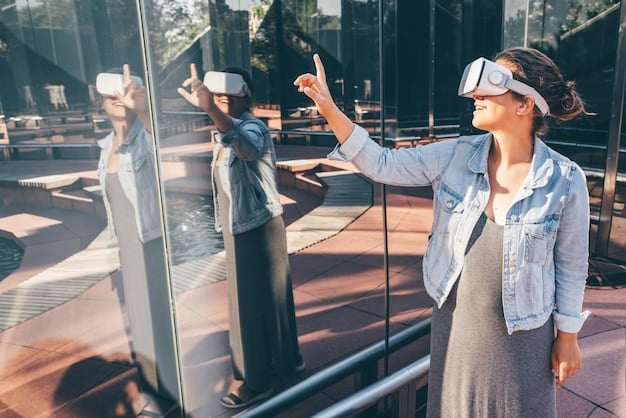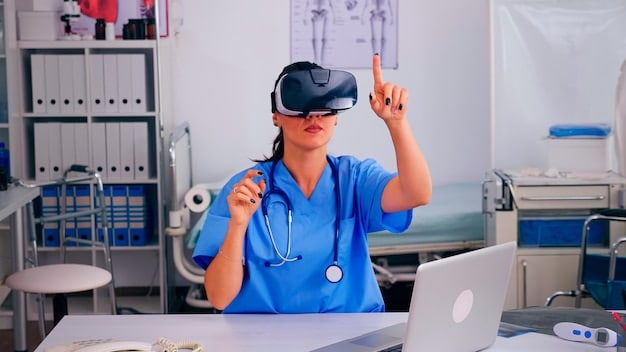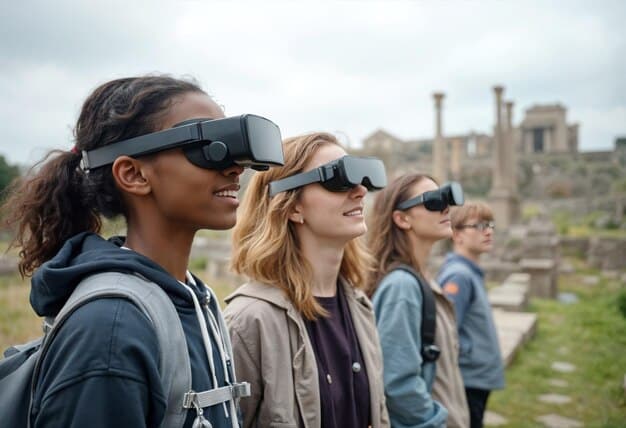Decoding the Metaverse: VR’s Future in the US After 2024

Decoding the Metaverse: What’s Next for Virtual Reality in the US After the 2024 Hype? explores the evolving landscape of VR technology, focusing on its potential applications beyond entertainment and its impact on various sectors within the United States following the initial hype.
Decoding the Metaverse: What’s Next for Virtual Reality in the US After the 2024 Hype? As the initial excitement surrounding the metaverse begins to settle, questions arise about the future of virtual reality (VR) technology in the United States and its lasting impact on various industries.
Understanding the Metaverse Hype: What Happened in 2024?
The year 2024 was marked by significant buzz around the metaverse, with major tech companies investing heavily in virtual reality and augmented reality technologies. This period saw a surge in VR gaming, virtual social platforms, and initial explorations into enterprise applications of the metaverse.
The Initial Investment and Expectations
Venture capitalists and tech giants poured billions into metaverse-related projects, fueling rapid advancements in VR hardware and software. The expectation was that the metaverse would quickly become the next major computing platform, transforming how people work, play, and interact.
Challenges and Setbacks
Despite the initial excitement, the metaverse faced several challenges, including technological limitations, high hardware costs, and concerns about user adoption. Many early VR experiences were clunky and unengaging, leading to a decline in user interest and a reassessment of the metaverse’s potential.
- Technological Hurdles: Limited processing power and network bandwidth hindered the development of truly immersive VR experiences.
- High Costs: The price of VR headsets and related equipment remained a barrier for many consumers.
- Content Scarcity: A lack of compelling and diverse VR content contributed to user dissatisfaction.
The metaverse hype of 2024 provided valuable lessons about the realities of VR technology and the importance of addressing technological and content-related challenges. Moving forward, the focus will likely shift towards more practical and use-case-driven applications of VR.

The Current State of VR Technology in the US
As we move beyond the initial hype, the VR landscape in the US is evolving towards more focused applications and realistic expectations. The current state of VR technology reflects both the progress made and the challenges that remain.
Advancements in VR Hardware
VR headsets have become more powerful, affordable, and user-friendly. Companies like Meta, HTC, and Valve continue to innovate, introducing new features and improved performance. These advancements are crucial for enhancing the user experience and driving adoption.
Focus on Enterprise Applications
While consumer adoption of VR has been slower than expected, enterprise applications are gaining traction. VR is being used in training simulations, product design, remote collaboration, and various other industries. These use cases offer tangible benefits and ROI, making them more appealing to businesses.
VR in Education and Training
VR is revolutionizing education and training by providing immersive and interactive learning experiences. Students and professionals can now practice skills in realistic virtual environments, improving their performance and retention rates. This is particularly valuable in fields like medicine, engineering, and aviation.
- Medical Training: VR simulations allow medical students to practice surgeries and other procedures without risk.
- Engineering Design: Engineers can use VR to visualize and interact with 3D models of their designs.
- Aviation Training: Pilots can train in realistic flight simulators that replicate various weather conditions and emergency scenarios.
The current state of VR technology in the US is marked by a shift towards practical applications and continuous improvements in hardware and software. While the metaverse may not have lived up to its initial hype, VR is proving its value in specific industries and use cases.
Key Industries Driving VR Adoption
Several industries are at the forefront of VR adoption, leveraging the technology to improve efficiency, reduce costs, and enhance training. These industries are driving innovation and creating new opportunities for VR developers and hardware manufacturers.
Healthcare
The healthcare industry is using VR for a variety of applications, including surgical training, patient rehabilitation, and mental health therapy. VR provides a safe and controlled environment for practicing complex procedures and treating various conditions. Studies have shown the effectivity of VR therapy when treating PTSD.
Manufacturing
Manufacturers are using VR for product design, assembly training, and quality control. VR allows engineers and technicians to visualize and interact with 3D models of products, identify potential issues, and optimize workflows. This reduces the chance for human error.
Education
As mentioned, VR is transforming education by providing immersive and interactive learning experiences. VR field trips, simulations, and interactive lessons are making education more engaging and effective. VR also helps to bring education to those who may not have access.

Retail
VR is enhancing the retail experience by allowing customers to virtually try on clothes, visualize furniture in their homes, and explore virtual showrooms. This helps customers make informed purchasing decisions and reduces the likelihood of returns.
These key industries are driving VR adoption by demonstrating the technology’s practical benefits and ROI. As VR hardware and software continue to improve, its applications will likely expand to other sectors as well.
Challenges to Widespread VR Adoption
Despite the progress made in VR technology, several challenges remain that are hindering its widespread adoption. Addressing these challenges is crucial for unlocking the full potential of VR and bringing it to the masses.
Hardware Costs and Accessibility
While VR headsets have become more affordable, they still represent a significant investment for many consumers. Additionally, the need for high-performance computers or gaming consoles to power VR experiences can further increase the overall cost. The price range can range anywhere from $300 to over $1,000.
Content and Software Limitations
The availability of compelling and diverse VR content remains a major challenge. Many VR experiences are still short, unengaging, or lacking in depth. As VR becomes more mainstream, content will have to adapt.
- Content Variety: The VR ecosystem needs more diverse and engaging content to appeal to a wider audience.
- Software Development: Developing high-quality VR software requires specialized skills and tools.
- User Experience: Some VR experiences can be unintuitive and difficult to navigate, deterring new users.
Motion Sickness and Discomfort
Motion sickness is a common issue for many VR users, particularly those who are new to the technology. This can be caused by the mismatch between visual stimuli and physical sensations, leading to nausea and discomfort.
Overcoming these challenges requires continued innovation in hardware and software, as well as a greater focus on user experience and content development. By addressing these issues, the VR industry can pave the way for widespread adoption and unlock its full potential.
Future Trends and Predictions for VR in the US
Looking ahead, several key trends are expected to shape the future of VR in the US. These trends include advancements in hardware, the integration of AI, and the expansion of VR applications across various industries.
Advancements in Hardware and Display Technology
VR headsets are expected to become lighter, more powerful, and more comfortable to wear. New display technologies, such as micro-OLED and holographic displays, will improve image quality and reduce motion sickness. Further advancements mean enhanced VR experiences.
Integration of Artificial Intelligence (AI)
AI is expected to play a significant role in enhancing VR experiences. AI-powered avatars, environments, and interactions will make VR more realistic and engaging. These developments are already in development.
Expansion of VR Applications Across Industries
VR is expected to find new applications in industries such as retail, tourism, and real estate. Virtual showrooms, remote collaboration tools, and immersive training programs will become more common.
These future trends indicate that VR technology will continue to evolve and find new applications in the US. While the metaverse may have faced setbacks, VR is proving its value in specific industries and is poised for continued growth.
The Metaverse’s Second Act: Beyond the Hype
As the initial hype surrounding the metaverse subsides, a more realistic and pragmatic approach is emerging. The focus is shifting towards practical applications of VR and AR technologies, rather than grandiose visions of a fully immersive virtual world.
A Shift Towards Practical Applications
Businesses and consumers are increasingly interested in VR and AR solutions that address specific needs and provide tangible benefits. This includes training simulations, remote collaboration tools, and immersive marketing experiences. The focus is now on benefits, not hype.
Collaboration and Interoperability
The future of the metaverse may depend on greater collaboration and interoperability between different platforms and ecosystems. This would allow users to seamlessly move between virtual worlds and access a wider range of content and experiences.
The Role of Regulation and Ethics
As VR and AR technologies become more integrated into our lives, it is important to address issues related to privacy, security, and ethics. Regulations and guidelines may be needed to ensure that these technologies are used responsibly and ethically.
The metaverse’s second act is likely to be characterized by a more measured and focused approach, with an emphasis on practical applications, collaboration, and ethical considerations. While the initial hype may have faded, the underlying potential of VR and AR technologies remains significant.
| Key Point | Brief Description |
|---|---|
| 🚀 VR Adoption | Healthcare, manufacturing, and education are driving VR adoption. |
| 💰 Funding Challenges | Hardware costs and content limitations hinder widespread VR use. |
| 💡 Future VR | Hardware improvements and AI integration are key future trends. |
| 🌐 Metaverse 2.0 | Practical applications and interoperability are crucial for the metaverse’s next phase. |
Frequently Asked Questions
▼
The hype was fueled by significant investments from tech giants into VR and AR technologies, driven by the vision of a transformative computing platform.
▼
Key challenges include high hardware costs, limited availability of compelling content, and issues with motion sickness and user discomfort.
▼
Healthcare, manufacturing, and education are at the forefront, leveraging VR for training, design, and immersive learning experiences.
▼
AI will enhance VR experiences by creating more realistic and engaging avatars, environments, and interactions within virtual worlds.
▼
The metaverse’s future lies in practical applications, collaboration between platforms, and addressing ethical considerations regarding privacy and security.
Conclusion
In conclusion, while the initial metaverse hype may have waned, the underlying potential of virtual reality in the US remains significant. By focusing on practical applications, addressing key challenges, and embracing collaboration and ethical considerations, the VR industry is poised for continued growth and innovation. The future of VR is not about replacing reality, but about enhancing it with new and exciting possibilities.





